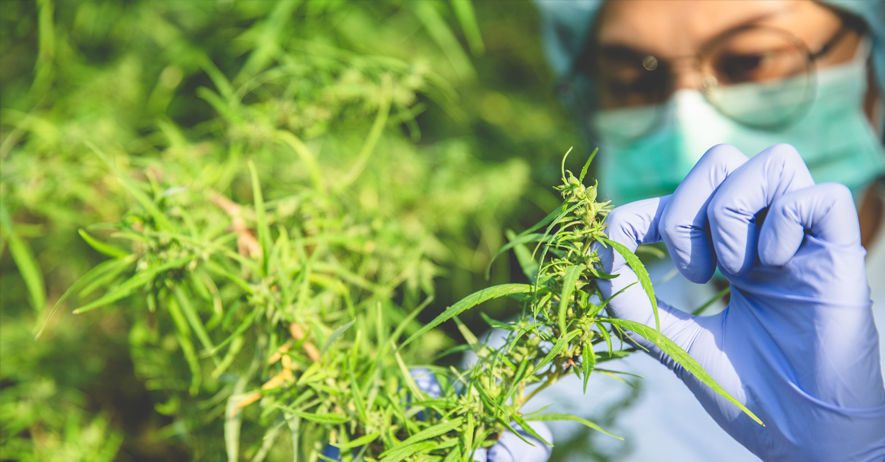Preventing Contamination in Medical Cannabis

As New Zealand’s medical cannabis industry continues to mature, expectations around product safety, quality assurance, and regulatory compliance are rising in parallel. One of the most under-examined, yet high-risk contributors to contamination and product recalls is the disposable glove.
Gloves are used at almost every stage of cultivation, harvesting, processing, and packaging. While they are intended to protect both product and people, poorly manufactured or unsuitable gloves can introduce microbial and chemical risks that undermine even the most robust quality systems. Protective clothing, including sleeve protectors, aprons, and splash jackets, is also critical to prevent contamination and protect workers.
This article explores why glove selection matters, how disposable gloves have contributed to recalls internationally, and how medical cannabis operators can reduce contamination risk through informed use of gloves and other PPE across the cultivation lifecycle.
Contamination Remains a Leading Cause of Cannabis Recalls
International data from Canada and the United States consistently shows that pathogen contamination is one of the most frequent causes of cannabis product recalls, second only to labelling or compliance issues in some jurisdictions. Common contaminants include:
- Fungi and moulds such as Aspergillus
- Bacterial pathogens
- Chemical residues, including pesticides and fungicides
Mandatory recalls involving Aspergillus-contaminated cannabis flower are common overseas, including the largest cannabis recall in Michigan’s history.
While New Zealand’s regulatory framework is robust, the risk factors that cause contamination are not unique to any one country. As local medical cannabis sales increase, so does the potential impact of a single contamination event—particularly where contamination sources are overlooked in Hazard Analysis and Critical Control Point (HACCP) plans.
Disposable gloves are one such overlooked risk.

Disposable Gloves: An Unexpected Contamination Point
Disposable gloves are intended to act as a protective barrier, yet recent research has shown that new, unused gloves can themselves be contaminated.
Independent testing commissioned by Eagle Protect revealed:
- Faecal indicator organisms were present on 50% of unused gloves tested
- Potentially harmful yeast species
- Fungal genera including Penicillium, Cladosporium, and Aspergillus
All of these organisms are capable of cross-contaminating cannabis during cultivation, harvesting, trimming, and packaging.
In one documented U.S. case, contaminated “food-safe” gloves were identified as the cause of a product recall at a pesticide-free cannabis producer. The gloves contained O-Phenylphenol (OPP), a chemical associated with carcinogenic risk, which transferred directly onto the crop.
Regulatory investigations have also linked glove contamination to:
- Inadequate manufacturing process controls
- Poor water quality during production
- Weak regulatory oversight in some manufacturing regions
- Improper storage conditions, including damp boxed gloves that allowed fungal growth
The FDA has also identified inadequate glove manufacturing process controls, leading to gloves contaminated with Aspergillus sp. and Fusarium sp. The gloves were subsequently recalled from the market.
For New Zealand operators, this underscores a critical point: glove quality is not guaranteed by price, thickness, or basic food-grade claims alone.
Gloves as Part of a HACCP-Based Risk Management Approach

As medical cannabis facilities refine their HACCP and quality management systems, disposable gloves should be treated as a critical control point, not a commodity item.
Gloves come into direct contact with cannabis plants, flowers, and finished products at multiple stages. A single contaminated box can compromise:
- Product safety and patient health
- Batch integrity
- Brand reputation
-
Regulatory standing
Equally important, gloves must also protect workers, particularly from prolonged exposure to resin, cleaning agents, and cultivation chemicals.
This means glove selection must balance cleanliness, durability, tactility, chemical resistance, and skin compatibility, depending on the task being performed.
Matching Gloves to Each Stage of Cultivation
Cannabis is a dynamic plant, and glove requirements change as it matures. Using the same glove throughout the entire process increases both contamination and efficiency risks.
-
Processing:
Cannabis plants and stems can snag gloves during processing, which requires slightly more durability. A 5mil+ nitrile glove provides strength and a slight texture for enhanced grip. If workers need additional arm protection, an 8mil+ nitrile glove with an extended cuff is recommended. Sleeve protectors or aprons can further protect clothing and skin from plant material and resin. -
Drying:
Hanging cannabis plants may seem simple, but dried plants can easily tear gloves. A 5mil nitrile glove is durable enough to withstand handling, while slightly textured surfaces improve grip. Protective clothing, such as aprons and sleeve guards, adds an extra layer of contamination control. -
Trimming:
Whether dry or wet, trimming requires both dexterity and durability. Gloves must resist resin buildup while allowing workers to feel fine details. A 4mil nitrile glove offers tactility without sacrificing strength. Accelerator-free gloves reduce the risk of skin irritation.
“These gloves are super durable when working with the cannabis flower. The glove doesn't tear as easily as the other gloves I use which are the same variety of product and I like how the grip on the fingertips are. The fingertips are super helpful and have been a life changer when working with the product, it feels like I can actually manoeuvre it without it slipping.” - Eagle Cannabis Customer
Key takeaway: Durability does not come from thickness alone. Manufacturing quality, raw material integrity, and elasticity are far more important indicators of performance.
6 Critical Factors When Selecting Gloves
1. Thickness and True Strength
Thicker gloves are not automatically stronger. Low-cost gloves may contain fillers such as chalk, which reduce elasticity and overall strength. Torn gloves release sweat, bacteria, and microorganisms, creating contamination risks.
The quality of ingredients and manufacturing standards is directly correlated to the quality of gloves produced. Here’s a quick and easy test to estimate the quality of your gloves.
2. Glove Grade
-
Sterile gloves are the cleanest gloves and are used in hospital environments, such as for surgery.
-
Medical examination grade gloves are subjected to a series of FDA-specified tests to ensure the gloves meet a defined list of safety requirements.
-
Food-grade gloves must meet minimum regulatory requirements (FDA Title 21 CFR Part 177), but this standard allows wide variation in quality.
-
Industrial-grade gloves are inconsistent and not recommended unless verified for food handling and have an Acceptable Quality Level (AQL) of 2.5 or lower.
For medical cannabis handling, medical-grade gloves or verified food-grade gloves with strong quality controls are highly recommended.
3. Cleanliness and Contamination Risk
Gloves should not introduce mould, fungi, pathogens, or chemical residues. This risk is real and documented here. Product purity can be compromised by a single contaminated glove box.
4. Skin Health and Worker Safety
Extended glove use can cause dermatitis, allergic reactions, and skin breakdown, especially when gloves are manufactured with poor-quality chemicals or accelerators. Worker comfort directly impacts compliance and productivity. Read how to avoid skin disease and hand issues caused by disposable gloves.
5. Acceptable Quality Level (AQL)
AQL measures pinhole defects. Gloves with an AQL ≤ 2.5 provide higher protection and consistency, aligning with medical-grade standards.
6. Chemical Protection
If workers handle cleaning agents, nutrients, or other chemicals, glove chemical resistance must be verified. Chemical protection varies widely between glove formulations.
Reducing Risk Through Verified Glove Quality
Preventing recalls requires moving beyond assumptions about glove safety and instead relying on verified quality systems.
Eagle Protect’s quality framework includes:
-
Consistent premium manufacturing specifications
-
Stringent raw material controls
-
Independent third-party laboratory testing through our Delta Zero™ programme to confirm the absence of unsafe chemicals and microbial contaminants
This approach is designed to reduce variability, protect workers, and minimise the risk of glove-related contamination entering the medical cannabis supply chain.
Our Recommended PPE Products
See our recommendations below of what Eagle nitrile gloves are best for each stage of production and testing process.
1. Disposable Nitrile Gloves

|

|

|

|
|
FineTOUGH (2.6mil) Our most tactile glove, these gloves are ideal for detailed work without sacrificing strength.
|
Sensitive (4mil) A tactile, but durable nitrile glove that provides protection from skin irritation and glove allergies.
|
Visible (5mil) A durable, fully textured nitrile glove that reduces ripping without sacrificing comfort.
|
Diamond Textured (6mil) A tough, diamond textured nitrile glove that reduces ripping and offers an enhance grip.
|
 |
|
|
|
|
Double Tough (8mil) Extra thick, strong and durable. Designed specifically where strength and coverage is required.
|
2. Disposable Clothing
 |
 |
 |
 |
|
Designed for the complete coverage of hair.
|
Soft, comfortable fit for
|
Elasticated for a firm fit to provide full arm coverage.
|
Foe use where minimal fluid droplet exposure may occur.
|
 |
 |
 |
|
|
Comprehensive level of waterproof front, back and shoulder protection.
|
Cost effective protection against spills and contamination.
|
Full body waterproof coverage with thumbhooks that ensure arm/wrist containment.
|
In medical cannabis, contamination prevention is not limited to the plant, the environment, or laboratory testing; it extends to every material that touches the product.
Disposable gloves sit at the intersection of product safety, worker protection, and regulatory compliance; therefore must be treated as a critical control point.
Selecting the right gloves and protective clothing for each stage of cultivation—from harvesting to processing—is a practical, achievable step toward safer medical cannabis production in New Zealand. Request samples today to experience the difference in quality, comfort, and protection for your team.


